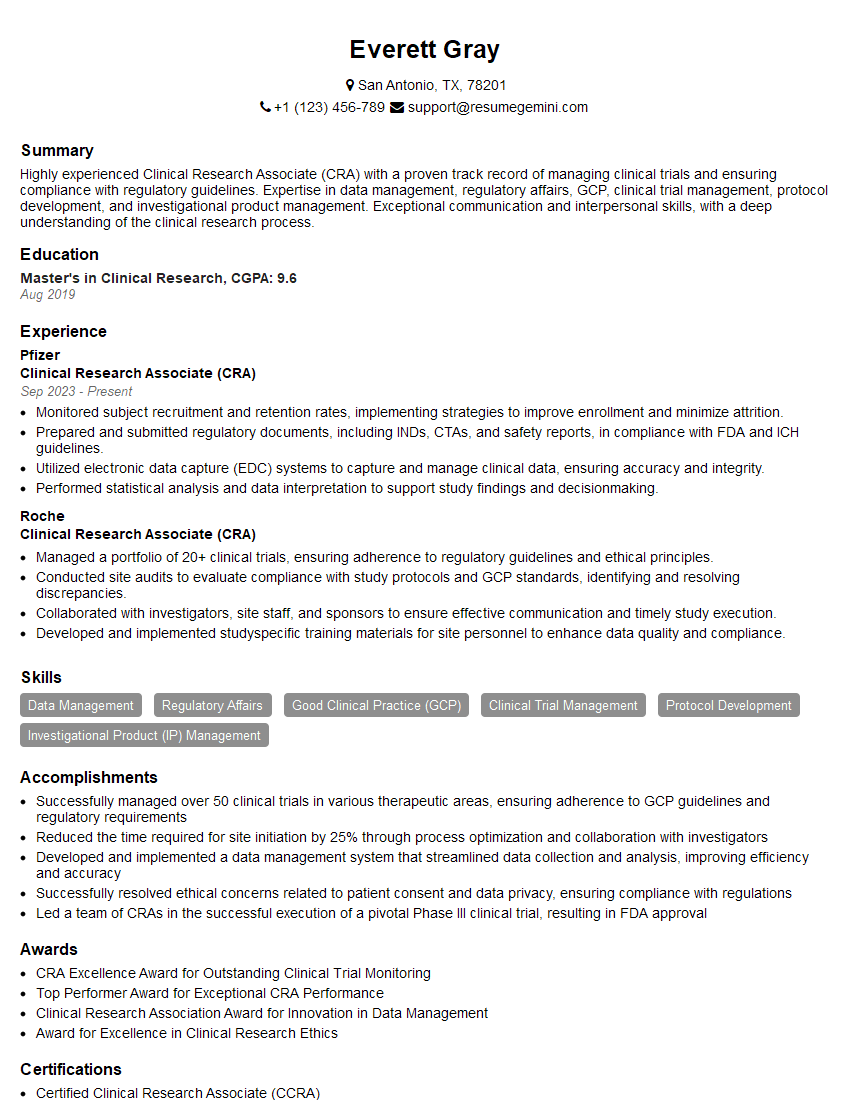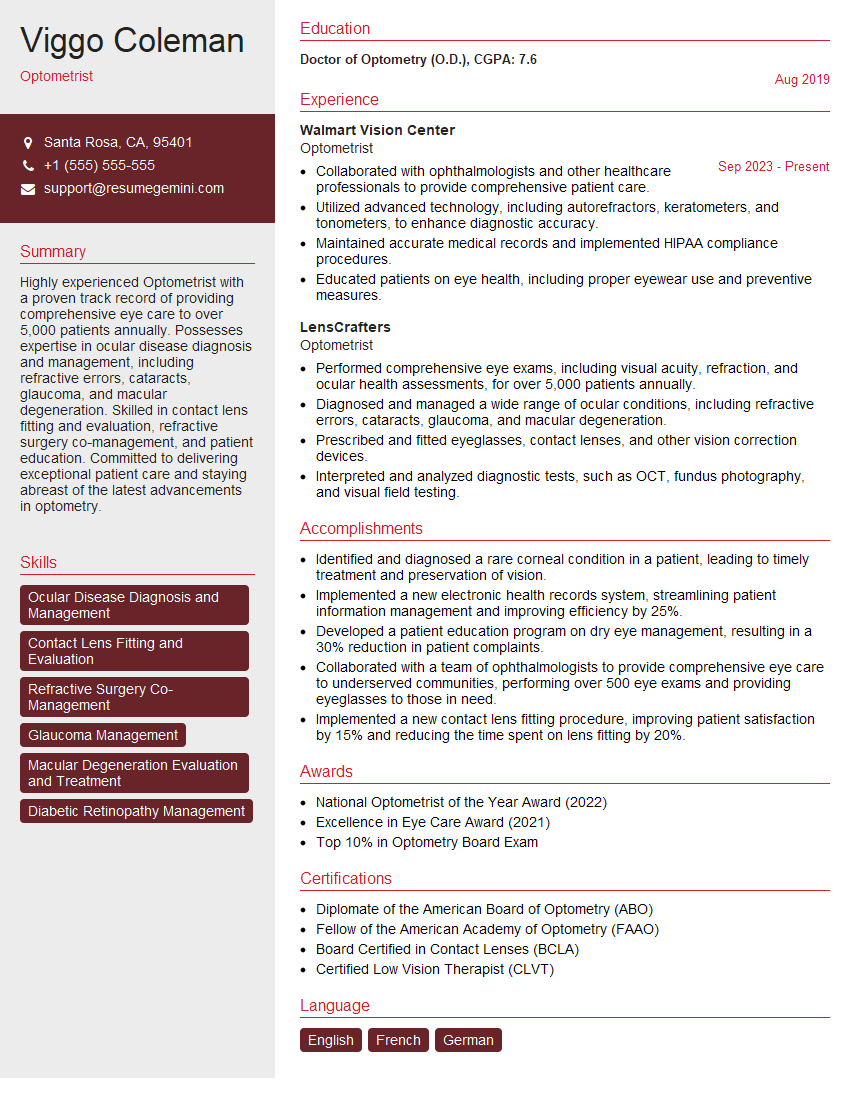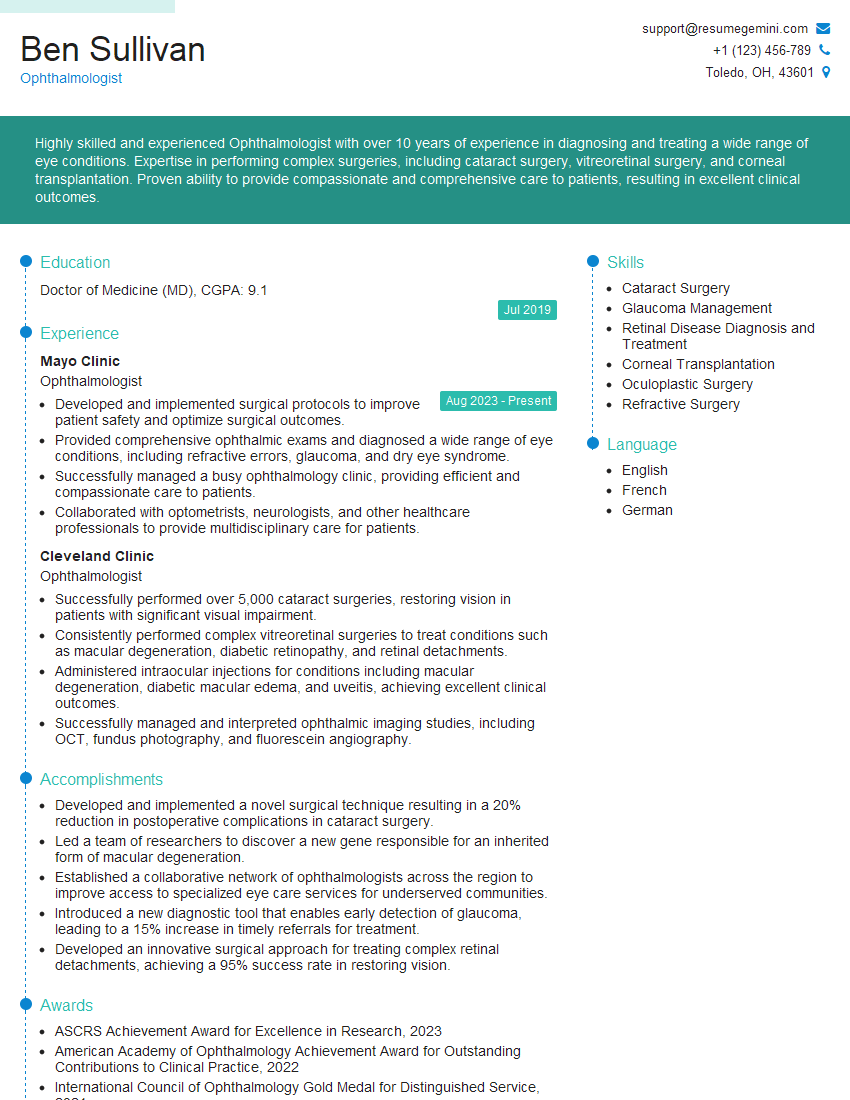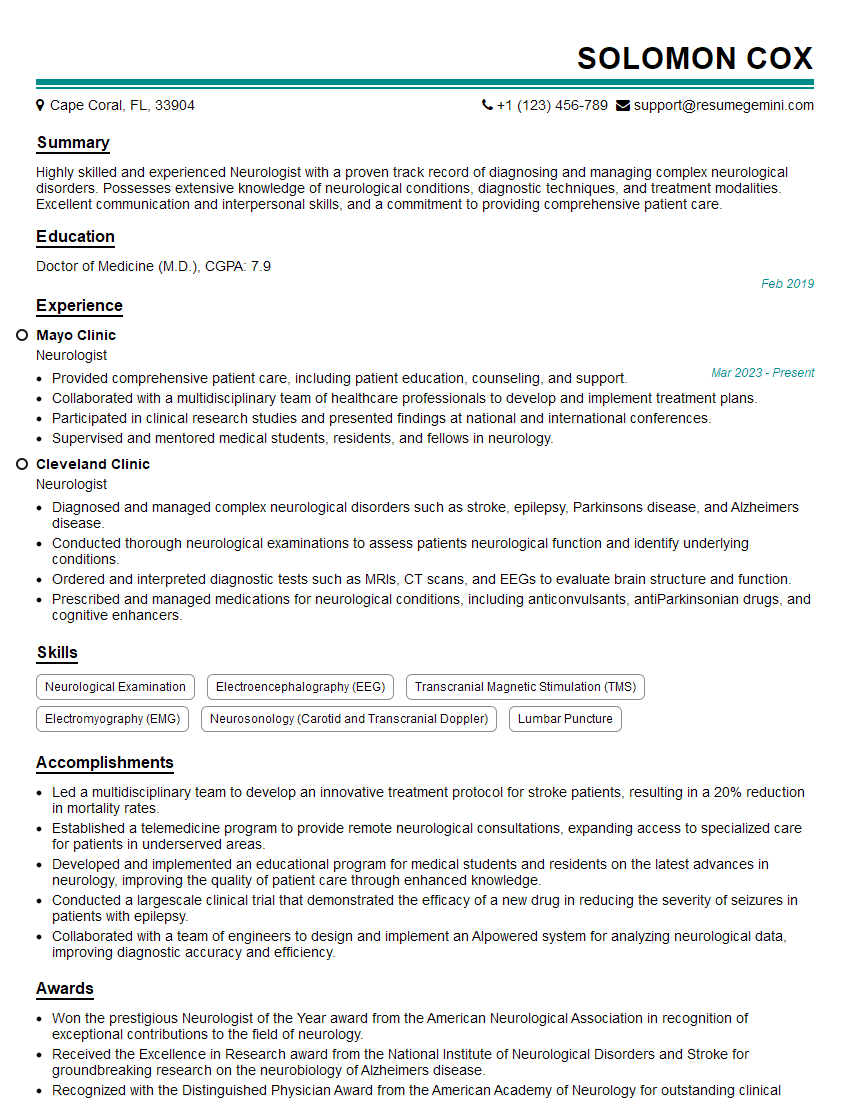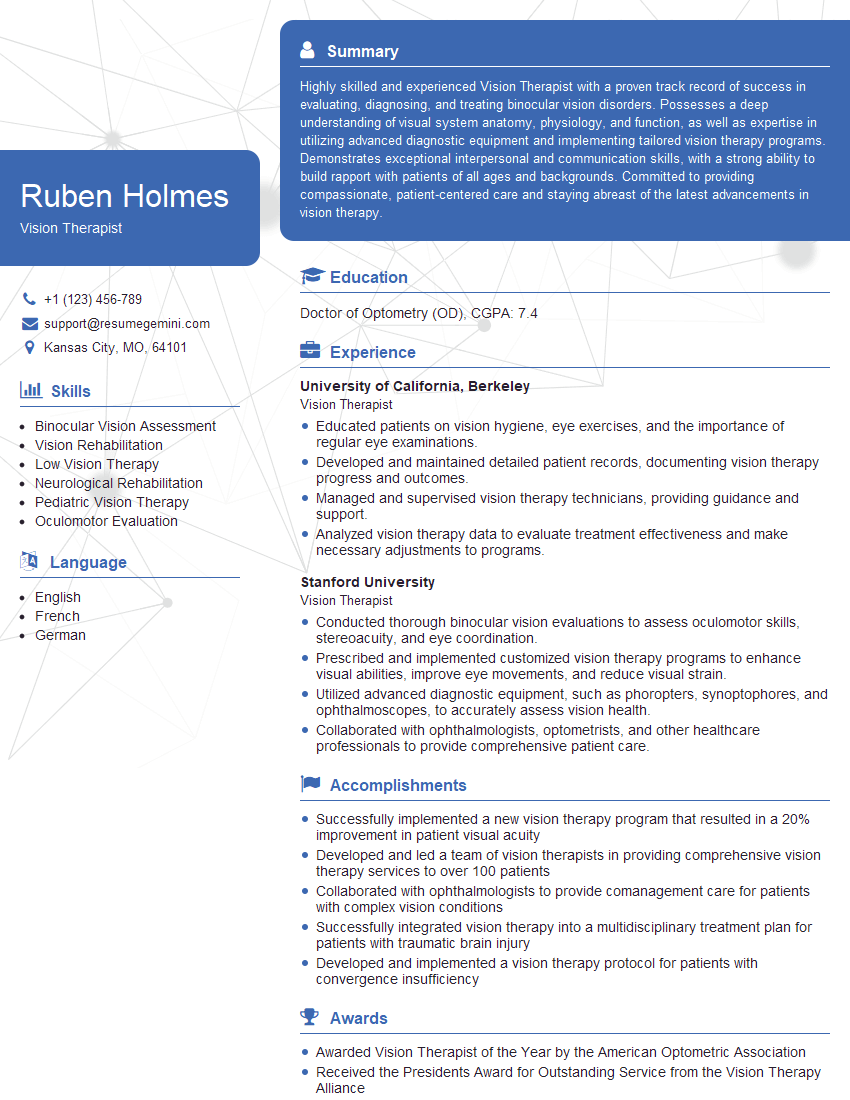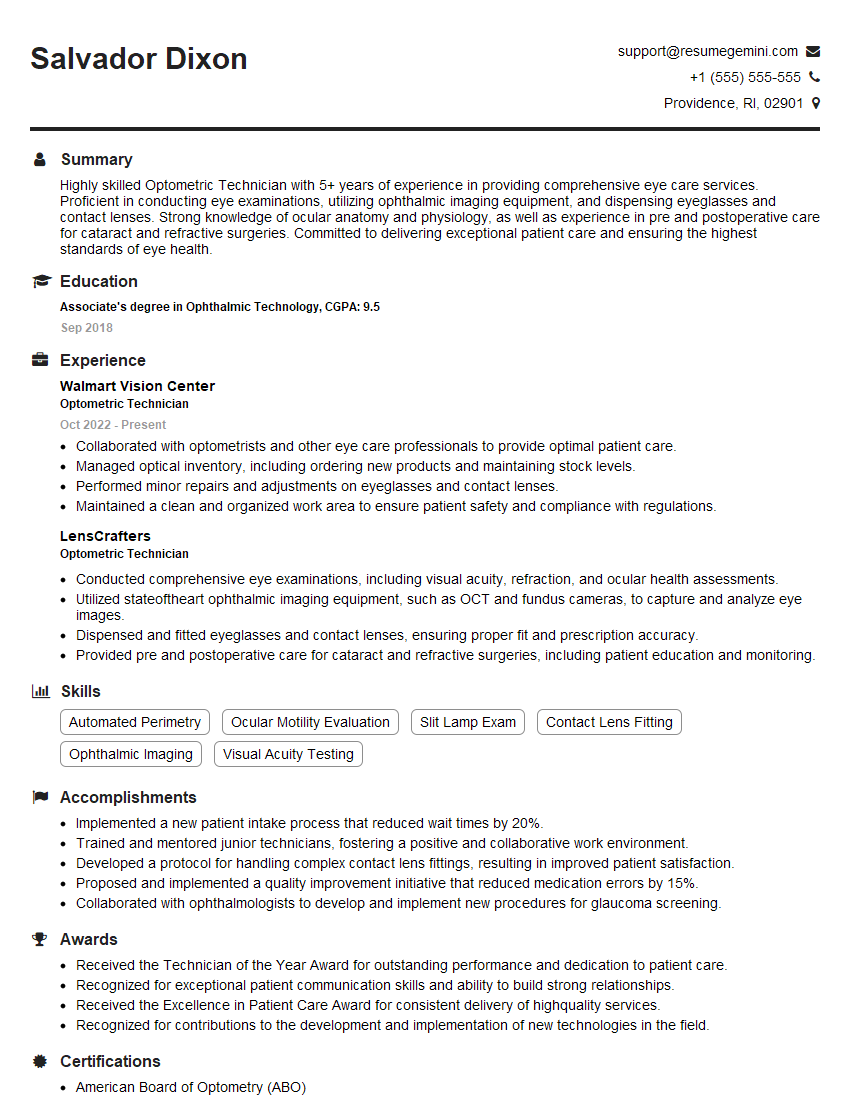Feeling uncertain about what to expect in your upcoming interview? We’ve got you covered! This blog highlights the most important Opto-Kinetic Nystagmus interview questions and provides actionable advice to help you stand out as the ideal candidate. Let’s pave the way for your success.
Questions Asked in Opto-Kinetic Nystagmus Interview
Q 1. Describe the physiological mechanism underlying Opto-Kinetic Nystagmus (OKN).
Optokinetic nystagmus (OKN) is a reflexive eye movement response to moving visual stimuli. Imagine watching a train go by – your eyes involuntarily follow the train, then quickly jerk back to fixate on a stationary point. This is OKN in action. Physiologically, it involves a complex interplay between several brain areas. The retina detects the moving visual field, sending signals to the visual cortex for processing. This information is then relayed to the brainstem, specifically the pontine nuclei, which integrate this input and generate the slow-phase pursuit movement. The fast-phase saccade, the quick reset of the eyes, is thought to be generated by the brainstem reticular formation. The cerebellum plays a crucial role in coordinating and smoothing the eye movements, ensuring accurate tracking.
In essence, OKN is a visually driven reflex that helps stabilize the image on the retina during movement, enabling clear vision. This differs from saccadic eye movements, which are voluntary and rapid jumps between fixation points. Think about how your eyes move when scanning a page—those are saccades, whereas following a moving object is heavily influenced by OKN.
Q 2. Explain the difference between OKN and Vestibulo-ocular reflex (VOR).
While both OKN and the vestibulo-ocular reflex (VOR) are involuntary eye movements that stabilize gaze, they differ significantly in their stimulus and underlying mechanisms. VOR is triggered by head movements detected by the vestibular system in the inner ear. It’s like an internal gyroscope, keeping your eyes fixed on a target even when your head is turning. This is crucial for maintaining stable vision during head movements. OKN, on the other hand, is driven by visual stimuli—it is triggered by the movement of objects in the visual field. Imagine the difference between a spinning chair (VOR) and watching a moving car (OKN).
In summary:
- VOR: Head movement stimulus; vestibular system-mediated.
- OKN: Visual movement stimulus; visual system-mediated.
They both contribute to overall gaze stability, but they are distinct systems with different triggers and neural pathways.
Q 3. How is OKN elicited during a clinical examination?
Clinically, OKN is elicited by moving a visual stimulus, such as a striped drum or a rotating screen, in front of the patient’s eyes. The direction and speed of the movement should be varied, ideally in both directions (right-to-left and left-to-right). The examiner observes the patient’s eye movements for the presence and characteristics of nystagmus. The patient should be instructed to follow the moving stimulus with their eyes. It’s important to ensure good lighting and to minimize any distracting factors.
Different types of stimulators exist, from simple hand-held drums to sophisticated automated systems that can quantify the response. The choice of stimulator depends on the clinical setting and the specific information required.
Q 4. What are the typical characteristics of normal OKN?
Normal OKN is characterized by a smooth, slow-phase pursuit movement in the direction of the moving stimulus, followed by a rapid saccadic reset in the opposite direction. The response should be symmetrical and well-maintained across both directions of movement. The slow phase velocity should be roughly proportional to the velocity of the stimulus. If the stimulus is moving slowly, the slow-phase movement will be slow, and vice versa. In a healthy individual, you should observe a robust and symmetrical response to stimulation in both directions.
Asymmetry, decreased response, or an absence of OKN may indicate underlying neurological pathology.
Q 5. Describe the different types of OKN abnormalities and their associated pathologies.
Abnormalities in OKN can manifest in several ways, and their characteristics can offer clues to the underlying pathology.
- Asymmetric OKN: A reduced response in one direction compared to the other, suggestive of a unilateral lesion (often in the brainstem or cerebellum).
- Reduced or Absent OKN: This can be seen in various conditions, such as bilateral brainstem lesions, cerebellar damage, or severe visual impairment.
- Dissociated OKN: This refers to a situation where the slow-phase movement is present, but the fast-phase movement is absent or significantly reduced, indicating a specific dysfunction within the neural circuitry responsible for generating the saccades.
- Optokinetic Afternystagmus (OKAN): This is a persistence of nystagmus after the stimulus is removed, sometimes indicating brainstem or cerebellar dysfunction.
The specific type of abnormality and its severity often help clinicians narrow down the potential causes. For example, asymmetrical OKN may point to a lesion in a specific hemisphere, whereas globally reduced OKN might suggest diffuse brain damage.
Q 6. How can you differentiate between central and peripheral causes of OKN abnormalities?
Differentiating between central and peripheral causes of OKN abnormalities relies on a thorough neurological examination combined with the OKN findings. Peripheral causes typically involve issues with the visual pathways (e.g., retinopathy, optic neuritis) or the vestibular system. These usually affect the entire visual field or cause specific visual field defects. Central lesions, on the other hand, affect the processing of visual information in the brain. The patterns of OKN abnormalities usually reveal more about the location and extent of the central lesion.
For instance, asymmetrical OKN is more indicative of a central lesion, such as a brainstem stroke, while a significantly reduced OKN response in both directions suggests more diffuse central or bilateral damage.
Careful consideration of other neurological findings, such as visual field deficits, cranial nerve examination results, and other neurological signs, is crucial in determining whether the cause is central or peripheral. A complete clinical picture is always essential.
Q 7. Explain the role of OKN testing in the diagnosis of neurological disorders.
OKN testing plays a valuable role in the diagnosis and localization of neurological disorders affecting the visual pathways, brainstem, and cerebellum. By assessing the characteristics of OKN, clinicians can gain insights into the integrity of these structures and identify potential lesions. For example, asymmetrical OKN can help pinpoint the side of a brainstem lesion. The presence or absence of OKAN might indicate cerebellar involvement. In combination with other neurological tests, OKN helps in making a more precise diagnosis.
It’s particularly useful in evaluating patients with suspected neurological conditions such as multiple sclerosis, stroke, tumors, and traumatic brain injuries. OKN testing provides objective data that complements subjective clinical findings, leading to a more comprehensive understanding of the patient’s condition and aiding in treatment planning.
Q 8. What are the limitations of OKN testing?
OKN testing, while valuable, isn’t without limitations. Its primary weakness lies in its inability to isolate specific parts of the visual pathway. A compromised OKN response could stem from various issues – problems in the retina, optic nerve, brainstem, or even higher cortical areas. This lack of specificity makes pinpointing the exact location of the lesion challenging. Furthermore, the test relies on the patient’s ability to follow the moving stimulus, making it unreliable in infants who may not cooperate or have limited attention spans. Finally, subjective interpretations of the nystagmus characteristics can introduce variability between examiners. Consider this: observing a slightly reduced OKN response might be due to mild fatigue, not a serious neurological issue. Careful clinical judgment, alongside other diagnostic tools, is crucial for accurate interpretation.
Q 9. Describe the equipment used for OKN testing.
OKN testing utilizes relatively simple equipment. The most basic setup involves a rotating drum or a moving striped pattern projected onto a screen. The drum usually has alternating black and white stripes, creating a clear visual stimulus. The speed and direction of the rotation can be controlled, allowing for the assessment of both slow and fast phases of the nystagmus. More sophisticated systems incorporate video-oculography (VOG) or infrared video cameras to objectively measure eye movements, providing quantitative data on the amplitude, frequency, and velocity of the nystagmus. This objective measurement enhances the accuracy and reproducibility of the test, minimizing the subjectivity inherent in visual observation.
Q 10. How do you interpret the results of an OKN test?
Interpreting OKN results involves analyzing several parameters. We look at the presence or absence of nystagmus, the amplitude (size) of the eye movements, the velocity of the slow phase (how fast the eyes track the moving stimulus), and the symmetry of the response between the two eyes. A normal response shows a smooth, symmetrical pursuit of the moving stimulus in both directions (temporal-to-nasal and nasal-to-temporal). Asymmetry or absence of the response, particularly a significant difference between responses in the two directions, indicates potential pathology. For example, a stronger response when the stimulus moves from the temporal to the nasal visual field compared to the opposite direction could suggest a lesion affecting the pathways involved in the nasal-to-temporal tracking. We also observe the characteristics of the fast phase, which are corrective saccades, and their relation to the slow phase; this can also offer insights into neurological processes. Any deviation from the expected pattern needs further investigation.
Q 11. How does age affect OKN responses?
Age significantly impacts OKN responses. Newborns exhibit robust OKN, even though their visual acuity is limited. As children grow, their OKN matures and becomes more refined. We typically see the full development of OKN by around 6 months of age. After that, the response tends to remain stable throughout childhood and adulthood. However, physiological changes in older adults may lead to subtle declines in OKN, often reflecting age-related changes in visual function. It’s important to compare the results to age-appropriate norms. A seemingly weak response in an elderly individual may be within the normal range for their age, while the same response in a younger patient might be considered abnormal. Therefore, the interpretation of OKN results must always consider the patient’s age and overall health.
Q 12. What are the common causes of impaired OKN in infants?
Impaired OKN in infants can point towards several serious conditions. Lesions affecting the brainstem, such as those caused by perinatal hypoxia (lack of oxygen during birth), can manifest as deficient OKN. Other potential causes include hydrocephalus (fluid buildup in the brain), infections like meningitis or encephalitis, and congenital abnormalities affecting the visual pathways. Genetic disorders can also cause impaired OKN. For instance, certain forms of albinism can severely affect visual development, including OKN. In these cases, the impaired OKN often presents alongside other neurological and ophthalmological findings, such as strabismus (crossed eyes) or reduced visual acuity. A thorough clinical evaluation is essential to differentiate between various causes.
Q 13. Explain the impact of medication on OKN responses.
Many medications can influence OKN responses, either directly or indirectly. Sedatives, for instance, are likely to depress the response, resulting in a weaker or absent nystagmus. Conversely, some medications might have the opposite effect, causing increased nystagmus. Neurological medications or substances affecting neurotransmitters can influence the neuronal pathways mediating OKN. Similarly, medications that can affect visual acuity (such as certain antihistamines) can indirectly lead to altered OKN responses. To interpret OKN accurately, it’s crucial to account for any medications the patient is taking. When evaluating the test results, it’s important to note all current medications as they might influence results, necessitating further investigation or follow-up to isolate the actual underlying cause.
Q 14. How would you assess the integrity of the visual pathways using OKN?
OKN is a valuable tool for assessing the integrity of the visual pathways, though not with pinpoint precision. By observing the quality of the response – the presence, symmetry, and speed – we can infer the overall functionality of the visual system. If the response is absent or severely impaired, it suggests a significant lesion somewhere along the pathway, from the retina to the brainstem. Asymmetry of the response can suggest a unilateral lesion. A reduction in speed of the slow phase could be indicative of a disruption in the pathways responsible for smooth pursuit. However, it’s crucial to remember that OKN doesn’t pinpoint the exact location. Other diagnostic tools, such as visual evoked potentials (VEPs) and neuroimaging (MRI, CT), are often used in conjunction with OKN to achieve a more complete and accurate assessment. OKN provides an initial screening and valuable clinical clues to guide further investigations.
Q 15. How would you explain the concept of OKN to a patient?
Optokinetic nystagmus (OKN) is a type of eye movement that occurs when you look at a continuously moving visual stimulus, like a rotating drum or a flowing stream. Imagine you’re on a train watching the scenery whiz by – your eyes will involuntarily follow the movement, then quickly jerk back to fixate on a new point. This back-and-forth movement is OKN. It’s a normal reflex that helps us maintain visual stability while we or our surroundings are in motion. We use special tools in the clinic to stimulate this reflex and assess its function.
Career Expert Tips:
- Ace those interviews! Prepare effectively by reviewing the Top 50 Most Common Interview Questions on ResumeGemini.
- Navigate your job search with confidence! Explore a wide range of Career Tips on ResumeGemini. Learn about common challenges and recommendations to overcome them.
- Craft the perfect resume! Master the Art of Resume Writing with ResumeGemini’s guide. Showcase your unique qualifications and achievements effectively.
- Don’t miss out on holiday savings! Build your dream resume with ResumeGemini’s ATS optimized templates.
Q 16. What are the potential confounding factors that might affect OKN testing?
Several factors can influence OKN testing results, potentially leading to inaccurate interpretations. These confounding factors include:
- Patient Cooperation: Young children or patients with cognitive impairments may have difficulty maintaining focus on the moving stimulus, leading to unreliable measurements.
- Visual Acuity: Poor eyesight can significantly impair the ability to track the moving target, leading to reduced or absent OKN responses.
- Medication: Certain medications, such as sedatives or anti-anxiety drugs, can depress the central nervous system, affecting the OKN reflex.
- Fatigue: If the patient is tired or unwell, their OKN response may be weaker than expected.
- Neurological Conditions: Pre-existing neurological issues (other than the one being assessed) can affect eye movement control and confound OKN results. For example, a patient with a history of stroke might display atypical responses even before the current evaluation.
- Apparatus Malfunction: The accuracy of the test is heavily dependent on the proper functioning of the OKN stimulator. If the stimulus isn’t moving smoothly or at the correct speed, the results won’t be reliable.
Q 17. How can you ensure accurate and reliable OKN measurements?
Ensuring accurate and reliable OKN measurements requires meticulous attention to detail. Key strategies include:
- Careful Patient Preparation: Ensuring the patient understands the procedure, is comfortable, and is free from distracting factors like bright lights or noises is crucial. We also need to assess their vision and address any correctable issues using glasses or contact lenses.
- Standardized Procedure: Following a precise, standardized protocol for stimulus speed, distance, and direction minimizes variability. We must record the precise settings of the apparatus used.
- Appropriate Stimulus: Utilizing a high-quality opto-kinetic stimulator with a clear and easily trackable pattern is paramount. This allows for consistent measurement and minimizes artefacts.
- Multiple Measurements: Taking multiple measurements and averaging the results helps reduce the impact of random errors, enhancing the reliability of the final assessment. Recording slow and fast phases of nystagmus separately further improves accuracy.
- Calibration and Maintenance of Equipment: Regular calibration and preventative maintenance of the OKN stimulator are vital for accurate readings. Equipment should be checked regularly for functionality and proper speed calibration.
- Experienced Examiner: OKN interpretation requires considerable experience and expertise. A well-trained examiner is essential for proper interpretation of the findings, especially in cases of subtle or atypical responses.
Q 18. What are the ethical considerations involved in performing OKN testing?
Ethical considerations in OKN testing primarily revolve around patient autonomy, informed consent, and confidentiality. Patients must be fully informed about the procedure, its purpose, potential risks (minimal in most cases), and the use of the data collected. Their consent should be freely given and documented. All patient information gathered during the testing should be kept strictly confidential in accordance with relevant data protection regulations.
Q 19. Discuss the importance of documentation in OKN testing.
Thorough documentation of OKN testing is crucial for several reasons. It provides a permanent record of the examination, which is vital for:
- Legal and Insurance Purposes: Detailed records serve as legal and insurance documentation, supporting clinical decisions and preventing potential disputes.
- Monitoring Disease Progression: In neurological conditions, serial OKN tests can help track the progression of disease or the response to treatment over time, providing valuable insights into patient management.
- Research: Standardized documentation across different testing facilities contributes to robust data collection for research on OKN and related disorders.
- Communication: Comprehensive records facilitate effective communication among healthcare professionals involved in the patient’s care, enhancing collaboration and improving patient outcomes.
Documentation should include patient demographics, date and time of the test, the specific equipment used, stimulus parameters (speed, direction, type), detailed description of the OKN response (amplitude, frequency, symmetry), and any observations about the patient’s cooperation or limitations.
Q 20. How do you differentiate between spontaneous nystagmus and OKN?
Spontaneous nystagmus and OKN are distinct types of eye movements. Spontaneous nystagmus occurs involuntarily even in the absence of any external visual stimulus. It’s often a sign of underlying neurological dysfunction. Conversely, OKN is a reflexive response to visual motion.
The key differentiator is the presence of a moving visual stimulus. If the nystagmus disappears when the stimulus is removed, it’s likely OKN. If the nystagmus persists even with stationary fixation, it’s considered spontaneous nystagmus. In practice, a comprehensive neurological exam is necessary to properly differentiate between the two.
Q 21. What is the role of OKN testing in evaluating head injuries?
OKN testing plays a crucial role in evaluating head injuries, specifically in assessing the integrity of the brainstem and its pathways involved in eye movement control. Abnormal OKN responses – such as reduced gain (amplitude of eye movement), asymmetry between responses to rightward and leftward stimulus movement, or the presence of directional preponderance – can indicate brainstem damage resulting from a head injury. The pattern and severity of OKN abnormalities can help clinicians localize the lesion, assess the extent of the damage, and predict prognosis. For example, asymmetrical OKN responses could suggest a unilateral brainstem lesion.
Q 22. How is OKN used in the assessment of multiple sclerosis?
Optokinetic nystagmus (OKN) testing is a valuable tool in assessing multiple sclerosis (MS) because it helps evaluate the integrity of the pathways involved in gaze stabilization and visual processing. In MS, damage to the white matter tracts, particularly those in the brainstem and optic pathways, can disrupt these pathways, leading to abnormal OKN responses.
Specifically, clinicians look for asymmetries in OKN responses between the two eyes or reduced amplitude and velocity of the nystagmus. For instance, a patient with MS affecting the right optic nerve might exhibit a significantly weaker OKN response in the right eye compared to the left when stimulated with a moving target. This asymmetry can pinpoint the location of the lesion. Delayed latency or reduced gain (ratio of eye velocity to stimulus velocity) can also be indicative of MS.
It’s crucial to remember that abnormal OKN findings aren’t diagnostic of MS in isolation; they need to be considered alongside other clinical findings and neuroimaging results like MRI scans showing demyelination.
Q 23. Describe the use of OKN in the diagnosis of brain stem lesions.
OKN is incredibly useful in localizing brainstem lesions. The brainstem contains crucial structures involved in the vestibulo-ocular reflex (VOR) and optokinetic pathways, which are integral to OKN. Damage to these areas can cause characteristic abnormalities in OKN responses.
For example, a lesion affecting the medial longitudinal fasciculus (MLF), a major pathway in the brainstem, can result in internuclear ophthalmoplegia, leading to impaired adduction (inward movement) of one eye during horizontal OKN. Lesions affecting the vestibular nuclei or flocculonodular lobe of the cerebellum, both involved in gaze stabilization, can manifest as reduced gain or asymmetrical OKN.
By carefully analyzing the pattern and characteristics of abnormal OKN – asymmetry, reduced gain, direction-specific deficits – neurologists can pinpoint the likely location and extent of the brainstem lesion, guiding further diagnostic workup.
Q 24. How does OKN differ between horizontal and vertical stimulation?
Horizontal and vertical OKN responses are mediated by distinct neuronal pathways, resulting in subtle but important differences. Horizontal OKN, usually evoked by a horizontally moving stimulus, involves the pons and the medial longitudinal fasciculus. Vertical OKN, triggered by vertically moving stimuli, relies on pathways involving the superior colliculus and other midbrain structures.
Clinically, we observe differences in the responses. Horizontal OKN is typically more robust and easier to elicit than vertical OKN in healthy individuals. Asymmetries are more easily detected during horizontal OKN due to the greater involvement of specific brainstem structures in the pathway. Patients with specific lesions affecting the vertical gaze pathways may exhibit normal horizontal OKN, yet show impaired vertical OKN.
Imagine it like two separate roads: one leading horizontally to the city center (horizontal OKN), and the other leading vertically to a mountain top (vertical OKN). Damage on either road will affect its functioning independently of the other.
Q 25. What are some alternative methods used to assess similar neurological functions?
Several alternative methods assess similar neurological functions relating to gaze control and visual processing. These include:
- Saccadic eye movements: Assessing the speed and accuracy of rapid eye movements in response to visual targets helps evaluate brainstem and cerebellar function.
- Smooth pursuit eye movements: Assessing the ability to follow a moving target smoothly assesses the integrity of the visual tracking pathways.
- Vestibulo-ocular reflex (VOR) testing: Assessing eye movements in response to head rotations helps evaluate the integrity of the vestibular system and its connections to the brainstem.
- Visual evoked potentials (VEPs): Recording electrical activity in the brain in response to visual stimuli helps assess visual pathway integrity.
- Magnetic resonance imaging (MRI): Imaging techniques like MRI can provide a detailed anatomical picture of the brain and its structures, allowing the visualization of lesions.
These tests, when used in conjunction with OKN, provide a more comprehensive evaluation of the patient’s neurological status.
Q 26. Explain how OKN contributes to gaze stabilization.
OKN plays a critical role in gaze stabilization, particularly during head movements and when tracking objects moving in the visual field. It helps maintain a stable image on the retina by generating compensatory eye movements that counter the movement of the visual scene.
Think of it like this: when you’re riding in a car, the world outside is moving, but your eyes can still focus on a specific object. OKN is one mechanism that allows your eyes to track and maintain fixation by creating a counter-movement. In essence, OKN acts as a ‘visual stabilization system’, complementing other reflexes like the VOR to maintain clear vision.
The interplay between OKN and the VOR ensures that our eyes remain fixed on the target even during head movement, facilitating clear vision and object tracking.
Q 27. Discuss recent advances or research in OKN testing and interpretation.
Recent advances in OKN testing and interpretation have focused on:
- Improved equipment and techniques: Digital video-oculography (DVO) has replaced older methods, providing more precise and objective measurements of eye movements.
- Quantitative analysis of OKN parameters: Sophisticated software allows for detailed analysis of OKN responses, including gain, phase, and latency, enabling a more precise assessment of neurological function.
- Development of more sensitive tests: Researchers are investigating more refined stimuli and analysis methods to detect subtle OKN abnormalities, particularly in early stages of neurological diseases.
- Integration of OKN with other neurophysiological tests: Combining OKN with other measures like VEPs and saccadic eye movements helps create a more comprehensive picture of neurological function.
Ongoing research explores the application of OKN testing in various neurological conditions, enhancing our understanding of disease mechanisms and aiding in earlier and more precise diagnosis.
Q 28. How would you troubleshoot a problem with OKN testing equipment?
Troubleshooting OKN testing equipment involves a systematic approach:
- Check the stimulus: Ensure the moving stimulus (stripes or pattern) is functioning correctly and providing adequate contrast and speed. A faulty stimulus is the most common source of error.
- Verify the recording system: Confirm that the electro-oculogram (EOG) electrodes are properly placed and making good contact with the skin. Poor electrode contact leads to noisy or absent signals. Inspect the cables and connections for damage or disconnections.
- Examine the software and calibration: Check the software for proper calibration and error messages. Ensure that the sampling rate and other parameters are correctly set.
- Test with known-good subjects: Performing a test on a healthy individual helps to verify that the equipment is working as expected and identify any systematic errors.
- Review recording quality: Examine the raw data for artifacts (e.g., eye blinks, movements unrelated to the stimulus). Artifacts can affect the accuracy of OKN measurement.
- Seek technical support: If problems persist, contact the manufacturer or a qualified technician for assistance. This is crucial to rule out hardware failure.
A methodical approach to troubleshooting is key in obtaining reliable and interpretable OKN results.
Key Topics to Learn for Opto-Kinetic Nystagmus Interview
- Definition and Physiology: Understand the physiological mechanisms underlying OKN, including the role of the vestibular system, visual pathways, and neural processing.
- Stimulus Characteristics: Analyze how different types of moving stimuli (e.g., stripes, rotating drums) affect the response and the implications for testing methodologies.
- Clinical Significance: Explore the diagnostic value of OKN in identifying neurological conditions affecting the visual and vestibular systems. Consider scenarios where abnormal OKN might be observed.
- Testing Procedures: Familiarize yourself with the various methods used to elicit and measure OKN, including their advantages and limitations. Understand the interpretation of results.
- Normal vs. Abnormal Findings: Develop a clear understanding of the characteristics of a normal OKN response and how to differentiate it from various pathological patterns.
- Differential Diagnosis: Learn to distinguish OKN from other types of nystagmus and related eye movement disorders. Consider potential confounding factors.
- Practical Applications in Different Settings: Discuss the use of OKN testing in various clinical settings, such as neurology, ophthalmology, and vestibular rehabilitation.
- Limitations and Challenges: Acknowledge the limitations of OKN testing and potential sources of error or variability in measurements.
- Research Advancements: Explore recent research and advancements related to OKN testing, analysis techniques, and clinical applications.
Next Steps
Mastering Opto-Kinetic Nystagmus is crucial for career advancement in fields requiring expertise in neuro-ophthalmology and related disciplines. A strong understanding of OKN demonstrates a comprehensive grasp of complex neurological processes and will significantly enhance your candidacy. To maximize your job prospects, it’s vital to create a resume that effectively communicates your skills and experience to Applicant Tracking Systems (ATS). ResumeGemini offers a trusted platform to build professional, ATS-friendly resumes tailored to your specific career goals. Examples of resumes tailored to Opto-Kinetic Nystagmus expertise are available through ResumeGemini, helping you present your qualifications in the most compelling way possible.
Explore more articles
Users Rating of Our Blogs
Share Your Experience
We value your feedback! Please rate our content and share your thoughts (optional).
What Readers Say About Our Blog
This was kind of a unique content I found around the specialized skills. Very helpful questions and good detailed answers.
Very Helpful blog, thank you Interviewgemini team.
